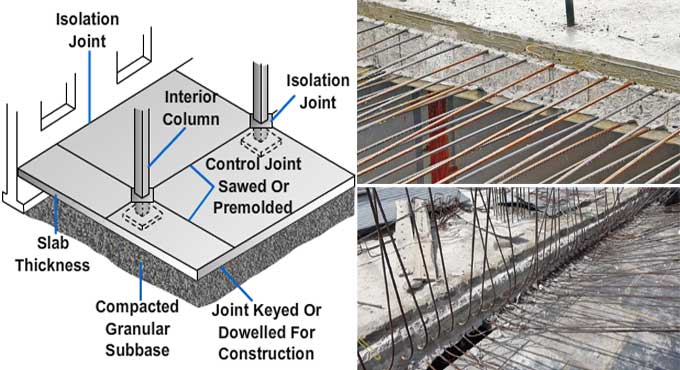
A Brief Overview of the Joints in Concrete Slabs
Moisture & temperature cause concrete to expand & shrink. At any age, there is a tendency for cracking due to shrinkage. Concrete cracks can be unsightly, but they do not compromise the material's integrity.
There are preplanned cracks at joints. Concrete slab joints are created by forming, tooling, sawing, and putting in joint formers.
Joints in construction are designed to eliminate weakened planes in concrete & allow cracks to occur at the proper location because of dimensional changes.
Joints such as isolation & expansion are used to isolate structural elements such as walls, footings & columns, driveways & patios from sidewalks, garage slabs, stairs, light poles, etc. Allow the structure to move independently vertically and horizontally and prevent cracks from forming.
Concrete slabs are successively stacked to form construction joints. They are generally dropped at the end of a workday but may be utilized if the time for concrete settling exceeds the duration of the day. Several slabs can move and transfer loads. It is important to plan joint locations prior to construction. A construction joint may be needed to achieve and continue reinforcing the bond.
Necessity of Construction Joints
It is impossible entirely to prevent concrete cracks, but they can be controlled & minimized through properly designed joints. Concrete cracks occur due to the following:
- It can develop tensile stresses that exceed its tensile strength if its natural tendency to shrink is restricted, resulting in cracks.
- When concrete is still young, most cracks are caused by temperature changes or slight contractions caused by setting & hardening. As concrete dries, it shrinks more and new cracks may appear, or existing cracks can widen.
Joints Construction
It is essential to design and construct joints properly to prevent uncontrolled cracks in concrete flatwork.
- It recommends that the maximum joint spacing is 24 - 36 times the slab thickness.
- It recommends that all panels be square or nearly so. If the length exceeds the width, it means that the length is too big. Ensure that you do not install L-shaped panels.
- A joint groove must not be deeper than one inch, but less than one-fourth the slab thickness. Depending on the type of jointing, the process may be sped up or slowed down:
1. Plastic or hardboard joint strips are inserted into the concrete surface to the depth required before finishing.
2. Tooled joints should be run early in the finishing process and rerun later to prevent grove banding.
3. According to the setting characteristics of the concrete, new entry dry cut joints are normally run 1-4 hours after completion of finishing. Typically, the joints obtained by this method are not as deep as those obtained by the conventional saw-cut process, but they should be at least one inch and a half deep.
4. Conventional saw-cut joints should be installed 4-12 hours after the concrete has finished.
- The strength of concrete & characteristics of aggregate affect raveling during saw cutting. Ravel in the joint edges should be delayed, however, if it takes too long to delay it, sawing will become difficult and uncontrollable cracking may occur.
- You can use pre-molded joint filler like asphalt- impregnated fiber sheeting, compressible foam strips or similar materials for isolation joints to separate slabs from buildings walls or footings. At least 2 inches of sand over the top of a footing will also prevent bond to the footing.
- It is imperative to clean all construction joints and remove all latitudes.
- It is necessary to wet all construction joints and remove all standing water before new concrete can place.
- Structures must not have joints that compromise their strength.
- Within the middle third of a span of a slab, beam, or girder, all construction joints must be clean and dry.
- Strata, girders, and slabs cannot support by vertical members that are still plastic.
- In general, because of the requirement of a monolithic slab system, beams, girders, haunches, drop panels, and capitals position monolithically.
Conclusion
In designing a building, the detail of joints is one of the most important elements, and only a qualified expert can provide this detail.
The joints of a building will enhance the appearance and give the desired performance when they design and construct well.


